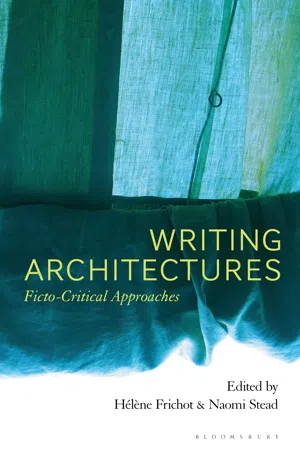
Writing Architectures
Ficto-Critical Approaches
- 264 pages
- English
- ePUB (mobile friendly)
- Available on iOS & Android
Writing Architectures
Ficto-Critical Approaches
About This Book
Architects and fiction writers share the same ambition: to imagine new worlds into being. Every architectural proposition is a kind of fiction before it becomes a built fact; likewise, every written fiction relies on the construction of a context in which a story can take place. This collection of essays explores what happens when fiction, experimental writing and criticism are combined and applied to architectural projects and problems. It begins with ficto-criticism – an experimental and often feminist mode of writing which fuses the forms and genres of essay, critique, and story – and extends it into the domain of architecture, challenging assumptions about our contemporary social and political realities, and placing architecture in contact with such disciplines as cultural studies, literary theory and ethnography. These sixteen newly-written pieces have been selected for this volume to show how ficto-critical writing can be a powerful vehicle for creative architectural practice, providing new opportunities to explore modes of writing about architecture both within and beyond the discipline. The collection represents a broad range of geographical and cultural positions including indigenous and non-Western contexts, and includes a foreword and afterword by important thinkers in the domains of architectural criticism (Jane Rendell) and cultural studies/ethnography (Stephen Muecke).
Frequently asked questions
Information
CHAPTER ONE
Prelude: The Ways in
Which We Write
Table of contents
- Cover
- Half-Title Page
- Title Page
- Contents
- List of Illustrations
- Notes on Contributors
- Acknowledgements
- 1 Prelude: The Ways in Which We Write
- 2 Waking Ideas from Their Sleep: An Introduction to Ficto-critical Writing in and of Architecture
- 3 From Site to Situation: Cutting Up as Fictocritical Composition
- 4 Construction (and Connection)
- 5 Incompossible Constructions of an Island Paradise
- 6 Archaeologies of Exile on Trikeri Island: Listening to Stones and Speculating on Prison Matters
- 7 In Which Robert Smithson Visits Christchurch: Ficto-criticism and the Field Trip
- 8 Hiroshima: Notes on the Expanded Field
- 9 Writing Walking: Ficto-critical Routes through Eighteenth-century London
- 10 The Indelible Traces of Her Footsteps
- 11 Sydney Letters: A to E
- 12 Outrage on Calle de Alcalá
- 13 The Aesthetic Recycling of Cultural Refuse
- 14 The Architect Who Couldn’t Write
- 15 Return to Cold Spring Harbor Laboratory after The Marriage Plot
- 16 The Bannister
- 17 Nice House, Woodland Lakes
- 18 The Door Left Ajar: On Dissident Waiting and Collective Fiction
- 19 Postlude: Fictocriticism after Critique
- Index
- Copyright